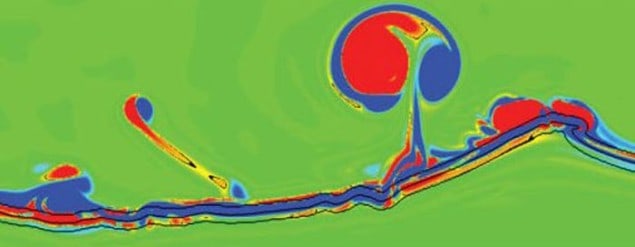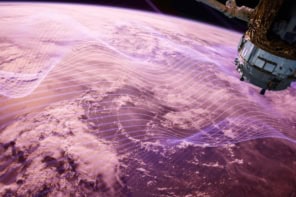
Ocean waves breaking far from shore impart a greater portion of their energy to the air than they do to the surrounding water. That is the claim of scientists in Italy and Australia who are the first to model the dynamics of the air directly over breaking waves. Although it has not been verified experimentally, the result challenges the previously held belief that most of a breaking wave’s energy remains in the water. If verified, the finding could have important implications for our understanding of cloud formation, climate modelling, oceanic circulation, and wave and weather forecasting.
While most waves do not break until they reach shallow water, particularly strong winds can cause them to do so out at sea – picture a classic storm with an ocean whipped full of whitecaps. But wind is not the only contributor to offshore breaking; modulation instability is a process by which small perturbations cause one or two waves within a set to grow unchecked. These waves draw energy from their neighbours until they reach a certain steepness threshold, when they break.
Current estimates suggest that 1–3% of all waves break at sea via this mechanism but until now it had been assumed that the energy released in the process was returned to the water. Indeed, our theoretical knowledge of what really goes on has been limited because calculations involve solving the nonlinear Schrödinger (NLS) equation. This involves making a number of significant approximations, including ignoring viscosity, vortex formation and, crucially, all air–water interactions. “The NLS equation can give you some ideas, but if you want to make one-to-one comparisons, you just don’t get good results,” explains Miguel Onorato, a physicist at the University of Turin who was involved in this latest work.
Tangled vortices
Onorato spent years studying modulation instability with the NLS equation but was eager to push the simulations to tell him more about the real world. To do so he turned to the Navier–Stokes (NS) equations – the central tenets of fluid mechanics, which incorporate all the complex forces and exchanges that the NLS equation willingly overlooks. However, solving the NS equations is famously difficult to do – both numerically and mathematically.
Onorato and colleagues used the NS equations to simulate wave breaking in two dimensions, by approximating the air and water as one single fluid with density and viscosity smoothly varying across the interface. The complexity of their model meant that each simulation took weeks to complete – unlike standard NLS models, which take minutes. But the investment was worth it: “It turns out there’s a lot going on in the air,” says Onorato.
The simulations showed that right before a wave breaks, it accelerates and its crest becomes sharp. As it breaks, the airflow on top of the wave suddenly separates from the crest and forms a vortex behind it – much like the vortices that form behind a spoon pulled through a cup of coffee. When the vortex makes contact with the water surface, it kicks up a second vortex of opposite sign, and the two tangle together in a capsule of counter-rotating air known as a dipole, and get thrown upwards into the atmosphere.
New perspective
When the scientists investigated just how much of a breaker’s energy is lost to this newly recognized dissipation route, they were staggered to find that up to three times more energy is transmitted to the air as is returned to the water. Onorato is careful to point out that this figure relates only to particularly steep waves, but the fact of the energies being comparable in order of magnitude is noteworthy.
Roger Grimshaw, a mathematician and wave expert at Loughborough University, who was not involved in the work, saw Onorato present the work at a workshop in Toronto last week. The talk “attracted a lot of interest”, he says, adding that the work “opens up a new perspective on air–sea interaction, which I believe has not previously been recognized, or indeed seen, either in numerical simulations, as here, or in observations”.
Climate contribution
Alex Babanin, an oceanographer at Swinburne University of Technology and co-author of the study, says “The implications for air–sea interactions, including weather and climate modelling, are significant but the large-scale models don’t simulate waves at all.” Instead, wind speed is used as a proxy for air–sea fluxes, but this can introduce errors of “hundreds of per cent” in the case of breakers resulting from modulation instability.
Although the team’s results are not immediately applicable in today’s climate models, a combination of scaling up the newly recognized contribution from breaking waves and improving the resolution of climate models should see a much more accurate picture of the interplay unfold. Babanin says “We now have a joint project with the Australian Bureau of Meteorology to do exactly that.”
Elsewhere, the team has already performed wave-tank experiments to confirm its computational results. Using a technique called particle image velocimetry, the team used a sheet laser and camera to reconstruct the velocity field of a smoky layer of air as waves broke underneath it. This new work is yet to be published but, says Onorato, “Visually, my collaborators could see those vortices in the air. Of course, there was no wind. The next step will be to add wind.”
The research is published in Physical Review Letters.



